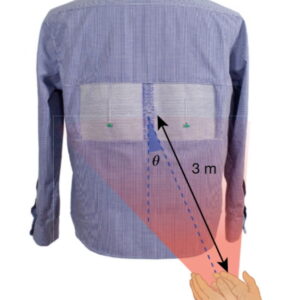
Imagine your apparel having the awareness to relay bodily movements to a hive of fans who want to experience your reality – in real-time. But there’s more. What if there was a way to monetize that unique exchange via your blockchain wallet? This reality has been coined as HuFi™ – Human Fidelity™ – and according to recent advancements, we are at the dawn of its unfurling.
Currently, markets are witnessing the maturation of technologies that will significantly impact how consumers engage with their finances and usage of casual apparel. Innovations that allow textiles to become “intelligent” are no longer confined to SyFy superhero tropes. Meanwhile, the disruptive ecosystem of blockchain, NFTs, and “pump and dump” crypto launches have created a host of rich overnight fantasies with polarizing results.
As with most emerging innovations, the timing of their mass adoption is difficult to pinpoint. There are a number of variables – whether controllable or spontaneous – that can significantly alter the outcome. The early usage of drones is a case study of how spontaneous variables such as a global pandemic sped up policy. Zipline, a drone manufacturer company that was struggling on paper was in the right place at the right time to provide their product due to policies that were literally approved overnight. The US passed an emergency air license in May 2020 to allow for Zipline drones to fly through emergency airline space. By December 2020 new sanctions allowed for drones to fly at night in rural and *urban locations. The outcome was hospitals being able to receive medical supplies in a more efficent way. Mind you, the medical field did not expect these type of sanctions – earliest – in 7-10 years.
The “industry” term for the rapid adoption of emerging technologies is Techceleraion. In this case, a spontaneous pandemic forced sanctions to be passed in efforts of controlling the outbreak. While COVID is not preferred method to speed up mass adoption, there are other more stable and predictable variants that have impact on how consumers and industries align for adoption.
When breaking down the aspects of mass adoption, I like using the “DropMe” technique. This was borrowed from an online debate with Gilbert Arenas v. old school NBA vets like Charles Barkley and such who suggest that current players would not do well if they played in the 1980s. The argument is due to the “physicality” and rules such as hand checking therefore current players would not post the statistics and dominance they are endowed with. Gilbert responded in a podcast, “Drop Lebron James into the Jordan era. Drop a 265-pound freak of nature into a league where very few believed in nutrition training staff allowing current players to play longer and more skilfully”. Swipe out Lebron with the current iPhone 13 and DropMe back to 2011 when the iPhone 4 launched. Apps we take for granted like Spotify would be impossible due to infrastructure issues – 3G v. 5G – as well as record labels and artists not being able to negotiate streaming royalties. Not to mention it wasn’t until about 2012-13 that smartphones reached critical mass, far from the novelty item when they first launched. I say this to support the argument that mass adoption is not just dependent on the readiness of the technology but yet an assortment of factors.
The above scenario demonstrates how an industry upgrades such as mobile networks and the rate of consumer engagement can determine just when a prediction can become a reality. What we take into these factors and apply them to the mass adoption of Smart Textiles and Blockchain? In what year would both be reliable enough to create new markets of fan engagement?
Computing Textiles
MIT recently released a video update on their Computing Textiles center where they define and demonstrate the incredible progress being made in the field. Yoel Fink,
“It’s exciting to really change the aesthetics of technology,” says Yoel Fink, who teaches the course, “Computing Fabrics,” to students from MIT and elsewhere. The class explores the history and future of fabrics, including next-gen textiles that will be beautiful and functional in entirely new ways.
What began as literally placing sensors on the fabric has now evolved into fiber being used as a substrate to weave in conductive elements. Recently, water-resistant capabilities have now enhanced the utility of the textile opening up a Pandora’s Box of innovations within the health, military and entertainment sectors.

Direction detection A shirt containing two fibres is used to detect the direction of a sound. Courtesy: Nature 10.1038/s41586-022-04476-9
But can Computing Textiles talk to each other? Can they relay data? According to Yan, one of the lead researchers on the joint RIT and MIT project:
The fabrics can also produce sounds, like a speaker, when an electric signal is applied to the piezoelectric fibre. The researchers even demonstrated that two shirts could communicate with each other by each receiving sounds and emitting recordings of spoken words. They also created a shirt containing two piezoelectric fibres that could detect the direction of a hand clap.
According to the team, such functions could have a number of uses, including helping those with hearing problems communicate. “Wearing an acoustic garment, you might talk through it to answer phone calls and communicate with others,” Yan explains.
Now we’re cooking with gas! Well…not literally but you get it. I’m betting the farm that the MIT/RIT collective is in the lab as we speak stirring up next-generation strange brew to launch in the upcoming months. This is just the beginning.
Blockchains and Things
Okay if you were late to the Crypto game and got sucked in by a pump n’ dump or were sucked into the hype of buying a bunch of useless NFTs only to discover the crypto AND the NFT are basically worthless, I assure you are in good company. Let’s back up a bit.
Unfortunately, the market was in such a frenzy that the buyer failed to conduct research. Culpability should be divided among the owner and the seller. Over the last couple of months, buyers of NFT Top Hoops have witnessed a tailspin in value of their assets due to creator Dapper Labs haveing a Robin Hood moment. By that, buyers were rich on paper, but not able to cash out or liquid their on paper assets.
An SB Nation survey showed that the vast majority of basketball fans weren’t interested in Top Shot — they thought it was obviously an artificial fad. Many compared Top Shot to Dutch tulip bulbs. [Bullets Forever]
With TopShots, fans are allowed to buy “Moments” which are snipets of a memorable play from an NBA Allstar. What started with a boom right around when Beeple sold his NFT for (Number). Then came the rain.
According to the article, NBA Top Shot: a short history of the largest mainstream NFT project:
You could buy in with a credit card — 80% of traders just bought with a credit card, not cryptos — but you needed to provide full KYC to cash out. This is known in crypto trading as the “KYC scam” — it’s a favourite with insolvent crypto exchanges.
the company also held onto customers’ money for an arbitrary waiting period — originally thirty days, later extended to six to eight weeks. Dapper claimed that this was necessary to prevent fraud, including chargebacks on credit card purchases of Top Shots.
Even when a customer was allowed access to what was supposedly their own frickin’ money, Dapper would cap withdrawals, starting at $1,000 per day. Dapper charged $25 for a wire transfer, and would take days to weeks to process each transfer. Dapper’s Identity Verification FAQ said: “most withdrawals are processed within 21 days but others may take 40 days or more.” [NBA Top Shot, 2021]
It’s already happening in other markets. For instance, the value of many NBA Top Shot NFTs has fallen more than 95% in just a few months now that the initial excitement has faded. It shouldn’t have been a surprise that 35,000 NFT copies of a random layup video wasn’t the wisest investment, but some consumers were swept up in the hype.
The original co-founders of NFTs (names) had this to say when asked about the current exploitive state of the digital asset:
- Comprehensive Public Safety Plan Survey: Equity - March 11, 2024
- Comprehensive Public Safety Plan Survey: Court System - March 11, 2024
- DC Comprehensive Public Safety Plan Survey: Surveillance // Privacy - March 11, 2024









